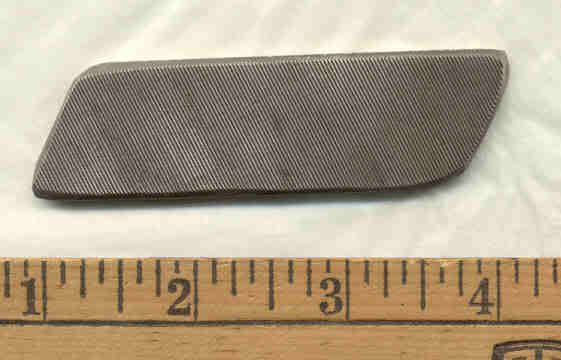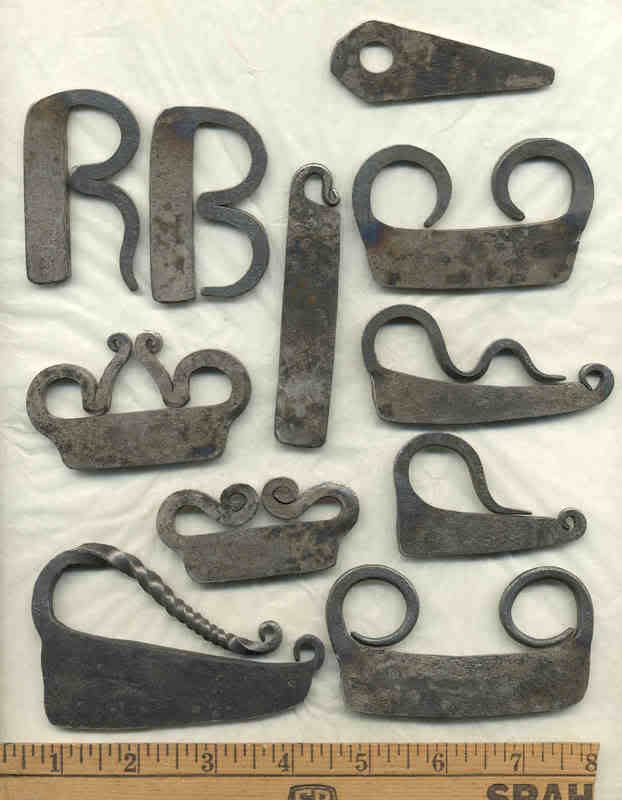Below are some of my humble thoughts that I wrote up and posted on a Living History forum. Some general info on fire steels (flint strikers), a simple file-to-striker project, scrounged steel types, and how I heat treat my fire steels. I made 650 flint strikers last year, and 500 the year before - with less than 10% of those being that classic C shape. Most were cultural or regional styles from all the time periods they were made/used in - from very early Roman times on up through the Middle Ages, North American fur trade, and up to the trenches of World War I. That's over 2500 years of use for such a simple tool of everyday life! One of these days I'll get this info more organized, and get a little booklet written up - with drawings/pics of specific styles and time periods, forging methods/steps, and heat treating.
I hope these humble ramblings help.
Thanks
Mike Ameling
The biggest problem with so many of the fire steels made today is that they are not heat-treated hard enough. When you try to strike sparks, your flint "digs in" too much - it "grabs" the steel instead of easily chipping out little bits of steel. And the bits it does chip out tend to be larger. The energy you put into chipping out those little bits of steel heats them up enough that the carbon burns - that's the sparks you see. If the bits of steel are too big, they have a hard time getting hot enough to burn - poor sparks or none. So they need to be heat-treated HARD.
But the drawback to a HARD heat-treat is an increase in how brittle they are - more prone to breaking. Some steps can be taken to make the striker less prone to breaking. But a good striker will break if you hit it too hard, or drop it on a rock. And it's Historically Correct - lots of broken strikers show up in archeological digs. You have to view a well made fire steel or flint striker as a "consumable" supply. It should spark well throughout it's whole life - but that life might be anywhere from only a few months up to several generations. The modern view is that you buy a fire steel once, and it should never break or wear out - no matter how they use/abuse it. Well, in the real world, things are a bit different.
Besides strikers not being heat-treated hard enough, the other big problem with many new strikers is that they are made of mild low carbon steel, and then case-hardened. The low carbon steel makes them very tough and hard to break, but they can't be hardened. So then they are "case hardened". Carbon is heated into the surface of the steel. But it only goes into the steel a fraction of an inch. These strikers spark very well when you first get them, but soon wear out. The amount and type of sparks that you get slowly decreases with use - as you wear through that case-hardened layer. They are great in that you almost can't break them - even by throwing them against a stone wall or hitting them with a hammer. But they wear out fast. And frustration grows as the sparks decrease.
A good fire steel should spark well without having to work hard to get those sparks. You should be able to get good sparks from a light glancing hit of steel on flint. You should not have to BANG the two together just to get sparks. Such hard hitting of steel and stone could break a good fire steel.
A good way to view this would be to compare a File and a Knife. Both get heat-treated very hard initially. The file is left that hard, but the knife gets tempered back - slowly heated up a little to make it less brittle but still hold an edge well. A poor striker ends up like that knife blade - too soft to get good sparks out of. A good striker is like that file - hard and easy to get good sparks from.
An old Boy Scout Flint Striker Project
A good, quick, striker project that you can make yourself is to make one from a scrap of a file - without any heat-treating or forging. Clamp about 3 inches of a worn file in a vise, and hit it with a hammer on the flat side right next to the vise. The part sticking out should snap right off. Drape a rag over it first to control any "shrapnel". Now take that chunk of file and grind the teeth off of one of the narrow edges. Cool it often. If it's getting too hot to hold in your fingers, cool it right away in water. You need to grind off all of the teeth, and get down to solid metal. Also grind a bit of the teeth off of each side along that narrow side. Those teeth interfere with using it as a striker. Now grind off any sharp edges from breaking off your chunk of file - this saves on cut fingers. You now have a pretty good using striker. They work great. This is an old project that a bunch of the Boy Scouts used to do. They ain't pretty, and you have to use a "pinch" grip, but they make a great striker. And they are historically correct. In most archeological digs, when they find a small section of a file, the usually just view it as a broken file. A check of the wear on the narrow edges would quickly show if it was used as a striker. A bunch were.
I hope my humble ramblings have helped clear up some of your questions. Fire steels are a bit of a passion for me. They have an amazing history - over 2500 years of use! And were made in dozens of styles/variations. I make hundreds of them a year, and less than 10% are that classic C shape. Such a simple everyday tool used throughout history from when man first started working iron.
There's lots of little hints, but here are a few.
Use new spring steel if you can. Old steel can have hidden problems in them. Lots of people use garage door springs and hay dumprake teeth to make their fire steels. They work well, but you can find cracks in them that don't show up until you are forging the steel, or after your final quench. I order my HR 1095 carbon steel from Admiral Steel. They will sell small quantities. Be sure to tell them that you are a Knife Maker.
A knife maker gave me one of the best tips I ever got about heat treating and not ending up with a fire steel that would practically break just by looking at it. Thermal Cycle the fire steel before final quenching. After all your forging is done, you heat it up to critical temp (where a magnet will no longer stick to it) and then pull it out of the heat and let it air-cool till you see no color. Next put it back in and do this heat/air-cool cycle two more times. Then heat it back up to critical and quench. This Thermal Cycling relieves the internal stress in the steel from the forging process, and refines the grain structure - making it smaller and more even. When you heat the steel above critical temp, the internal grain structure grows and expands, and then you stress the steel by forging it. Thermal cycling really helps a lot.
I often use new hayrake teeth. I get them from Farm Fleet for around $1.10 each. They are 1/4 inch round stock, and you end up with about 2 1/2 to 3 feet of rod after you unwind and straighten it. These work great for simple C strikers. You can taper each end, and then flatten them, or leave them in the round. Be sure to use a long enough piece to start with. A standard C striker requires around 6 to 7 inches of rod. The farm stores also sell another hayrake spring tooth that is only 1/8 inch round - good for small awls or large fish hooks. And a big double spring tooth that is 3/8 inch in diameter - for planters and chisel plows to help break up the clods. These are the same thickness as the old hay dumprake teeth. You end up with about 7 feet of rod after you unwind and straighten it.
I quench my fire steels completely in one motion. I haven't had much luck with that differential quench - first quenching the striking surface, then a little more, the 1/2 the striker, then finally the whole thing. I usually end up with cracks at the quench line when I do this. So I quench it all at once - in water. Then, if I think I need to, I selectively heat the handle portions up to soften them a little. But I usually only do this if I have some small/thin parts to the handle section.
I hope this helps. This blacksmithing does get "addictive".
yhs
Mike Ameling
p.s. Lawmower blades can work great for strikers. They are usually around 1084 to 1095 carbon steel, or 5160 alloy steel. Just chisel or cut them down to workable sizes.
A few of the dozens of possible styles/shapes of flint strikers made over the centuries.



